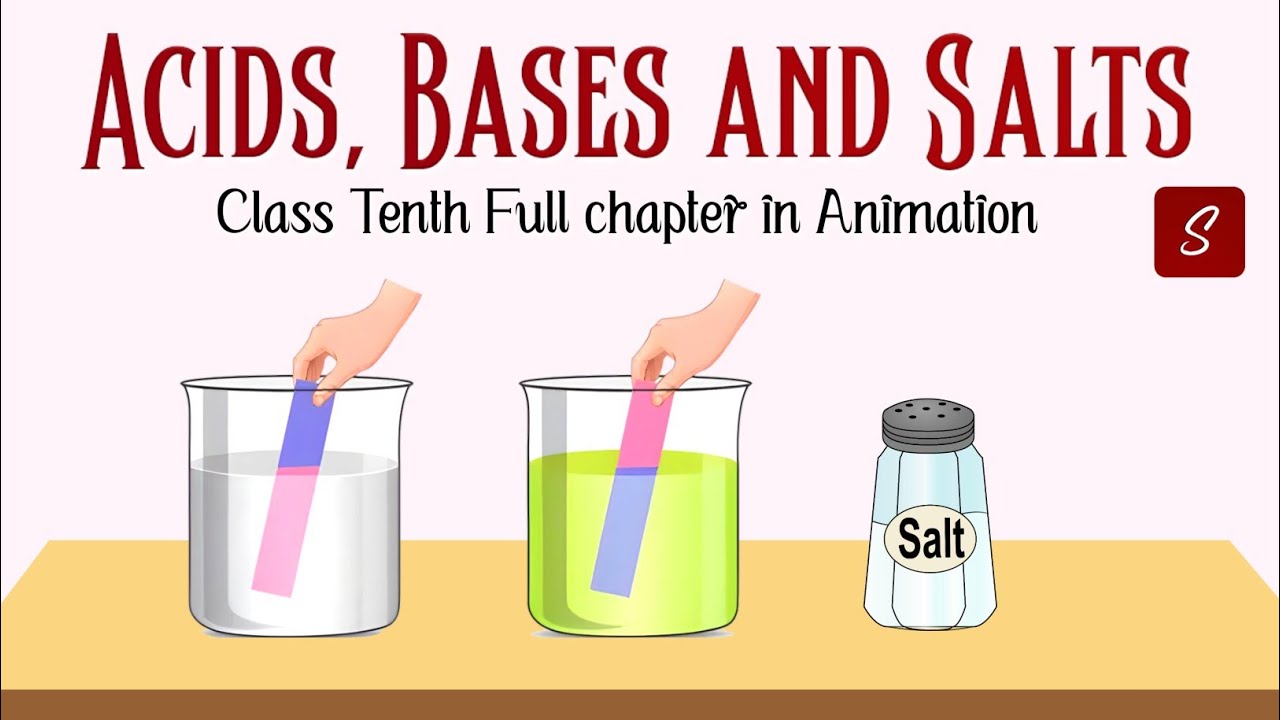Larutan Asam, Basa, dan Garam (2021)|Materi IPA SMP Kelas 7|
Summary
TLDRThis video explores the fundamental concepts of acids, bases, and salts, explaining their properties, examples, and everyday uses. It delves into the definitions of acids and bases according to the Arrhenius theory, providing examples such as vinegar, lemon, and soap. The script also covers the classification of acids and bases into strong and weak categories and their behavior in chemical reactions. Additionally, it explains the formation of salts through acid-base reactions, highlighting their neutral nature. Indicators and their color changes in response to acids and bases are also discussed to help viewers understand pH levels and acid-base characteristics.
Takeaways
- 😀 Acids are substances that release H+ ions in water and are responsible for the acidic properties, such as sour taste and pH below 7.
- 😀 Common examples of acids in daily life include vinegar (acetic acid), citrus fruits (citric acid), and grapes (tartaric acid).
- 😀 Acids are classified into strong acids, like hydrochloric acid (HCl), and weak acids, like carbonic acid (H2CO3).
- 😀 Strong acids can conduct electricity well, while weak acids conduct electricity poorly.
- 😀 Bases are substances that release OH- ions in water and have properties like bitter taste and a pH above 7.
- 😀 Everyday bases include soap (sodium hydroxide) and antacids (aluminum hydroxide).
- 😀 Strong bases, like sodium hydroxide (NaOH), can be corrosive, while weak bases, like ammonia (NH3), are less so.
- 😀 Salts are formed when an acid reacts with a base, such as sodium chloride (NaCl) formed from hydrochloric acid and sodium hydroxide.
- 😀 Salts are neutral, do not change the color of litmus paper, and can conduct electricity in solution.
- 😀 Indicators, such as litmus paper and natural indicators like red cabbage, can be used to identify acids, bases, and salts by color changes in the solution.
Q & A
What is the definition of an acid according to Arrhenius?
-An acid, according to Arrhenius, is a substance that releases H+ ions when dissolved in water.
What are some everyday examples of substances containing acids?
-Everyday substances containing acids include vinegar (acetic acid), citrus fruits (citric acid), grapes (tartaric acid), apples (malic acid), vitamin C (ascorbic acid), and eye drops (boric acid).
What are the main properties of acids?
-The main properties of acids include a sour taste, a pH less than 7, the ability to turn blue litmus paper red, the ability to conduct electricity, and being corrosive.
What is the difference between strong acids and weak acids?
-Strong acids, like HCl (hydrochloric acid) and H2SO4 (sulfuric acid), are capable of conducting electricity because they dissociate completely in water. Weak acids, like acetic acid and carbonic acid, do not dissociate fully and thus have a limited ability to conduct electricity.
How are bases defined and what ions do they release?
-Bases are substances that release hydroxide ions (OH-) when dissolved in water.
Can you list some common everyday examples of bases?
-Common examples of bases include soap, detergent (sodium hydroxide), antacids (aluminum hydroxide), bleach (ammonia solution), and some laxatives.
What are the properties of bases?
-The properties of bases include a bitter taste, a pH greater than 7, the ability to turn red litmus paper blue, the ability to conduct electricity, and being slippery and corrosive to the skin.
What are salts, and how are they formed?
-Salts are compounds formed when an acid reacts with a base in a neutralization reaction, resulting in the formation of a salt and water. For example, when hydrochloric acid (HCl) reacts with sodium hydroxide (NaOH), sodium chloride (NaCl) is formed.
What are some common examples of salts in everyday life?
-Common salts include sodium chloride (NaCl), calcium carbonate (CaCO3), potassium nitrate (KNO3), potassium carbonate (K2CO3), and sodium phosphate (Na3PO4).
How do indicators help identify acids and bases, and can you give some examples?
-Indicators are substances used to identify whether a solution is acidic or basic by changing color. Examples include litmus paper (which turns red in acid and blue in base), phenolphthalein (colorless in acid and pink in base), and bromthymol blue (yellow in acid and blue in base).
Outlines

Dieser Bereich ist nur für Premium-Benutzer verfügbar. Bitte führen Sie ein Upgrade durch, um auf diesen Abschnitt zuzugreifen.
Upgrade durchführenMindmap

Dieser Bereich ist nur für Premium-Benutzer verfügbar. Bitte führen Sie ein Upgrade durch, um auf diesen Abschnitt zuzugreifen.
Upgrade durchführenKeywords

Dieser Bereich ist nur für Premium-Benutzer verfügbar. Bitte führen Sie ein Upgrade durch, um auf diesen Abschnitt zuzugreifen.
Upgrade durchführenHighlights

Dieser Bereich ist nur für Premium-Benutzer verfügbar. Bitte führen Sie ein Upgrade durch, um auf diesen Abschnitt zuzugreifen.
Upgrade durchführenTranscripts

Dieser Bereich ist nur für Premium-Benutzer verfügbar. Bitte führen Sie ein Upgrade durch, um auf diesen Abschnitt zuzugreifen.
Upgrade durchführenWeitere ähnliche Videos ansehen

Química Simples #07 - Resumos - Funções Inorgânicas

Acids, Bases and Salts | Full Chapter | Class 10

ACIDS, BASES AND SALTS in 1 Shot FULL CHAPTER IN ANIMATION ||| NCERT SCIENCE Class 10th Chapter 2

Acids, Bases and Salts in 20 Minutes🔥| Class 10th | Rapid Revision | Prashant Kirad

HIDROLISIS GARAM PART 1 : SIFAT-SIFAT GARAM DAN MENENTUKAN REAKSI HIDROLISIS GARAM

Acids, Bases and Salts Class 10 Full Chapter (Animation) | Class 10 Science Chapter 2 | CBSE | NCERT
5.0 / 5 (0 votes)
